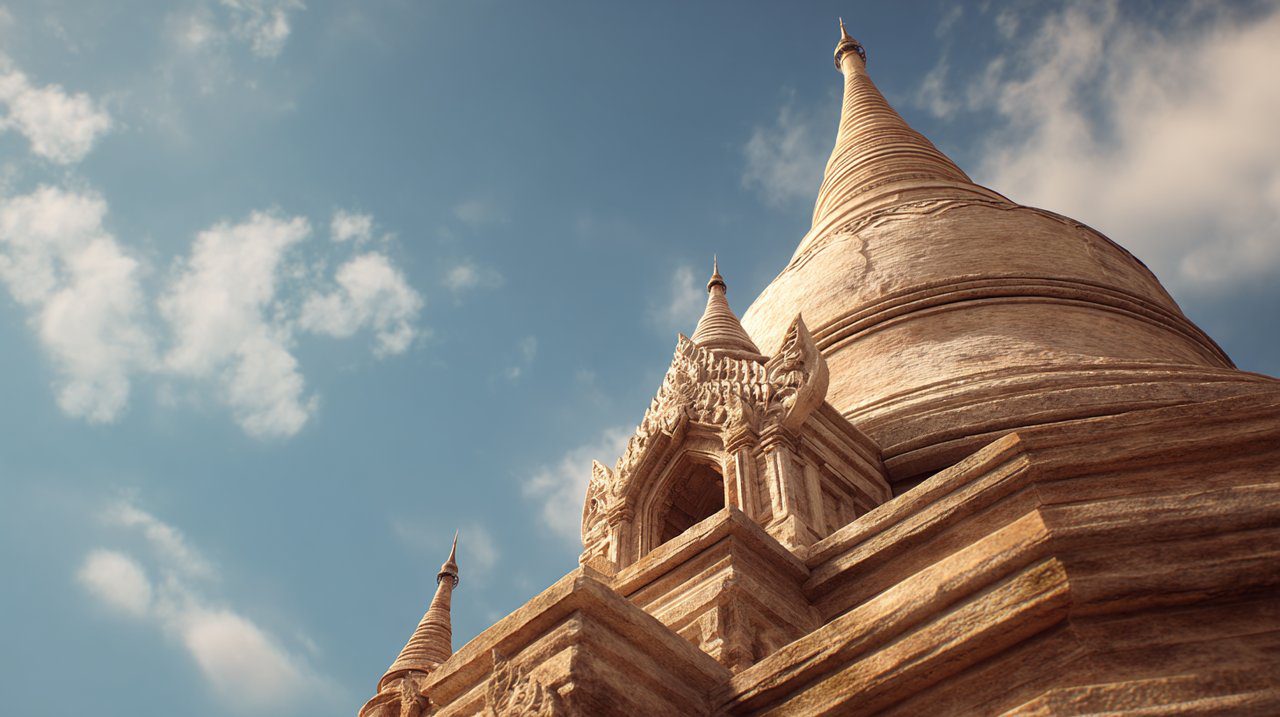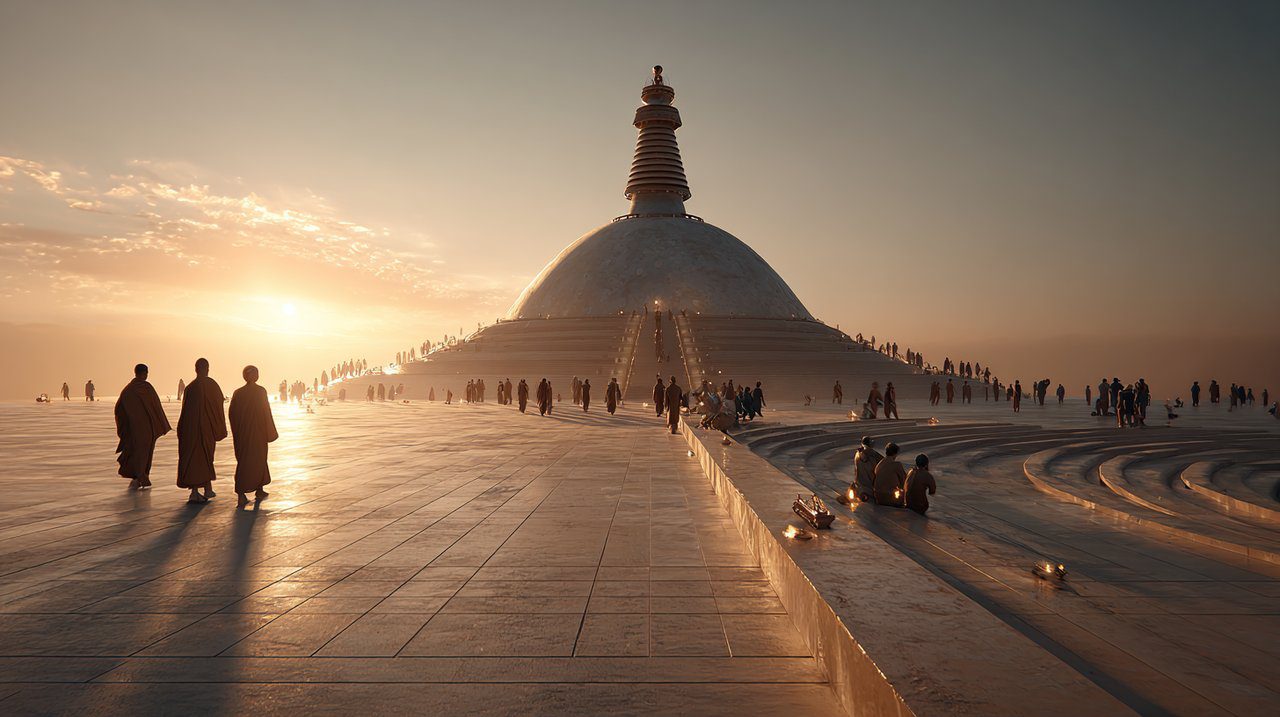The Stupa: A Sacred Structure Guiding Inner Awakening
Like ancient trees, their roots deep in the earth and branches reaching for the sky, the Stupa of Buddha stands as a profound expression of stillness, wisdom, and the inner journey. It teaches silently, a sacred diagram guiding inner awakening. But what exactly is a Stupa, and what profound insights does it offer us?
The Stupa: A Living Symbol of Awakening
At its heart, the Stupa is far more than just a structure. It’s a sacred mound, a vessel of immense spiritual significance. Its origins trace back to ancient India, where it first served as a reliquary for the remains of enlightened beings, most notably the Buddha himself.
Over centuries, this humble form evolved. It became a sophisticated expression of Buddhist Architecture that transcends mere design, transforming from simple earthen markers into elaborate monuments as Buddhism spread across the world.

Each curve and tier of a Stupa began to echo deeper philosophical truths. It moved beyond being just a burial site, becoming a living, breathing symbol of the Buddha’s awakened mind and the path to enlightenment.
Origins and Architectural Principles
The design of a Stupa is anything but arbitrary. It’s a precise articulation of Sacred Geometry, meticulously representing the universe and the spiritual journey towards enlightenment itself.
Think of it like a cosmic blueprint. The base, dome, spire, and finial each correspond to fundamental elements of nature—earth, water, fire, air, and space. More importantly, they also align with distinct stages of spiritual realization.
Standing before a Stupa, you can’t help but sense the harmony of its proportions. It’s a feeling akin to observing the intricate patterns of a snowflake or the perfect spiral of a fern – a testament to universal order.
The Stupa’s Symbolic Layers
The true power of the Stupa lies in its incredibly rich layers of symbolism. Every single aspect, from its foundational base to its crowning pinnacle, tells a compelling story of transformation and awakening.
It functions as a three-dimensional Mandala Symbolism, a cosmic diagram of the universe and the enlightened mind, inviting deep contemplation. What does this cosmic map reveal?
The traditional Stupa structure beautifully embodies the five purified elements and the five wisdoms of an awakened mind. Let’s break down these powerful connections:
- Square Base (Earth): This foundational element represents stability, the very ground of our being, and the profound wisdom of equanimity – a steady mind in all circumstances.
- Dome (Water): Symbolizing fluidity and the essence of life, the dome embodies the wisdom of mirror-like awareness, reflecting reality without distortion.
- Conical Spire (Fire): Reaching upwards, the spire denotes aspiration and transformation. It points to the wisdom of discriminating awareness, clearly discerning truth from illusion.
- Umbrella (Air): This element signifies protection and expansiveness, representing the wisdom of accomplishing activity – effortless and beneficial action.
- Jewel (Space): At the very top, the jewel represents emptiness, the ultimate reality, and the all-encompassing wisdom of boundless space.
This upward progression isn’t just a physical design; it symbolizes the stages of our own spiritual path. Each tier, each element, represents a vital step towards liberation. It gently reminds us that enlightenment isn’t a sudden flash, but a gradual, beautiful unfolding, much like the slow, persistent growth of a tree reaching for the light.
Spiritual Engagement and Practice
A Stupa is never just an object to be admired from afar. It’s an active participant in spiritual life. Engaging with a Stupa through various Meditation Practices and acts of devotion is a time-honored way to generate significant spiritual merit, purify negative karma, and accumulate positive energy.
One of the most common and powerful practices is circumambulation, or ‘kora’. This involves walking mindfully in a clockwise direction around the Stupa. This rhythmic movement becomes a form of walking meditation, transforming each step into a prayer.

As you circle, your mind naturally focuses on the sacredness of the monument, forging a deeper connection with its energy. It’s a gentle, repetitive act, much like the ceaseless flow of a river smoothing a stone, gradually refining the mind and spirit.
Every act of veneration, whether offering incense, prostrating, or even contributing to a Stupa’s construction or maintenance, is a powerful opportunity to generate merit. This positive energy supports your personal spiritual journey and contributes to the well-being of all beings.
It beautifully reflects the understanding that our intentions and actions have tangible effects, creating ripples of positive change in the very fabric of existence.
Guiding Principles: Karma and Compassion
The Stupa stands as a silent yet potent reminder of core Buddhist principles. It particularly highlights the interconnectedness of all actions and our inherent potential for liberation. Its tranquil presence encourages deep reflection on the cycle of Karma and Rebirth and, crucially, the cultivation of Compassion Practice.
Often seen as a beacon of peace, a Stupa radiates blessings to its surroundings. Its very existence is an act of profound compassion, offering a focal point for devotion and a source of inspiration for countless individuals.
It whispers of a universal peace that isn’t just found externally, but deeply within each of us, like the calm at the heart of a storm.
Every interaction with a Stupa, every moment of mindful presence, contributes to a larger web of positive energy. It reminds us that our individual spiritual efforts are never isolated; they actively contribute to a collective awakening.
Just as a single drop of rain contributes to the vastness of the ocean, your personal devotion adds to the spiritual current that flows through the world.
Your Invitation to Inner Discovery
The Stupa of Buddha, in its quiet majesty, offers so much more than historical significance or architectural beauty. It is a guide, a map, and a mirror. It reflects the journey of enlightenment, the wisdom of the universe, and the incredible potential within each of us.
Its presence gently invites us to pause, to reflect, and to embark on our own inner journey of discovery. In its silent embrace, we can find profound peace and purpose.
To truly understand its benefits is to engage with the path it represents – a path that continues to unfold with every mindful step we choose to take. So, what inner wisdom will you uncover today?
💡 Frequently Asked Questions
A Stupa is a sacred mound or vessel of immense spiritual significance in Buddhism. Originally serving as reliquaries for enlightened beings, it evolved into an elaborate monument symbolizing the Buddha's awakened mind and the path to enlightenment, acting as a cosmic blueprint for spiritual realization.
The Stupa's design is based on Sacred Geometry, with each part symbolizing fundamental elements and spiritual stages. The square base represents earth and equanimity, the dome represents water and mirror-like awareness, the spire represents fire and discriminating awareness, the umbrella represents air and accomplishing activity, and the jewel at the top represents space and boundless wisdom.
Circumambulation, or 'kora', is a practice of walking mindfully in a clockwise direction around a Stupa. This rhythmic movement serves as a form of walking meditation, helping to focus the mind on the sacredness of the monument, generate spiritual merit, purify negative karma, and accumulate positive energy.
A Stupa serves as a potent reminder of the interconnectedness of actions (Karma) and our potential for liberation. Its tranquil presence encourages reflection on the cycle of rebirth and the cultivation of Compassion. The Stupa itself is seen as an act of profound compassion, radiating blessings and offering inspiration.








